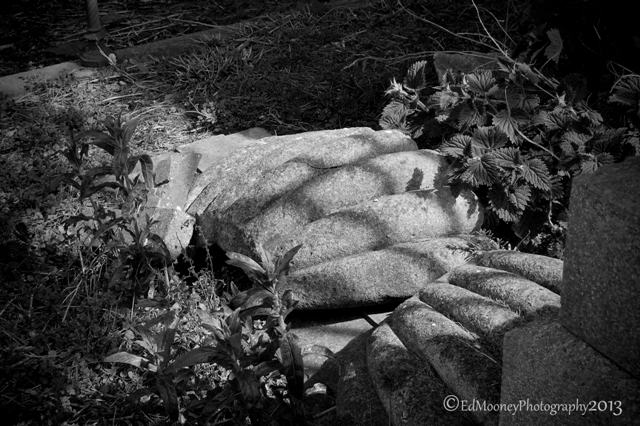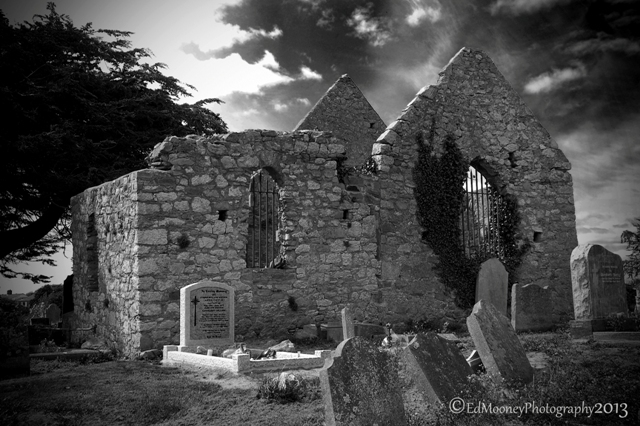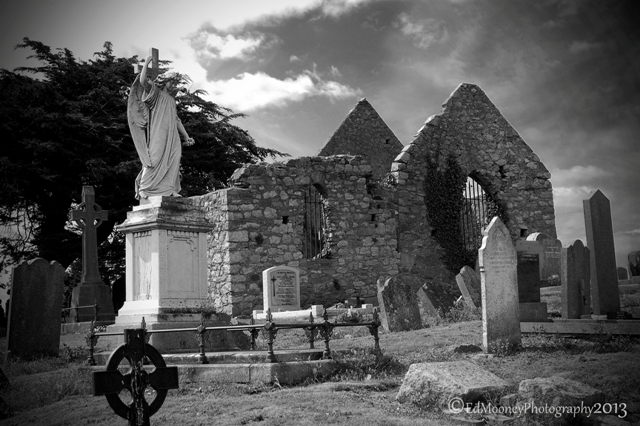I came across this little ruined church on the way out to Howth recently. It is situated on a raised piece of land right on the coast road with some great views of the surrounding area. In early Christian times the sea would have come much closer to the site as there was no road. There has been a Church on this site since the early 6th Century. This is typical early Christian site, consisting of a Church, a burial ground and a holy well. There was a well to the north of the Church, which was believed to be a cure eye ailments, sadly there is no longer any trace of the well to be found. The first Church or cell was probably quite primitive, with a straw or timber roof.
Kilbarrack owes its name to St Bearach, also spelled “Bearach”. According to tradition a holy person named Bearach (Barrog) came here with some followers and it is from him that the area got its name – CillBharrog, the Church of Barrog (Bearach). The monk who later became a Saint, established a church on this very site. St. Bearach spent some time there in his early days, and it has been claimed that he performed many miracles. Bearach was a native of Termonbarry in Roscommon. He was a disciple of St Kevin, and he died in 595 AD. The church has been referred to in some records as the Chapel of Mone. It was also known as a mariner’s Church, where sailors came to offer thanks for a voyage and to bury their dead. Long ago, ships entering Dublin Bay paid monies to the city authorities towards the upkeep of the chapel. The monks and sailors would have been the earliest burials. There are no stones marking these burial sites – if there ever were they have long since disappeared.
During excavations hereby an AnCO team in 1985, the archaeologist and historian Leo Swan dated the present structure from the 12th – 13th century with signs of much older foundations. The ruins consist of a nave and chancel with a side aisle to the south. A large railed fence has been placed where the Western gable stood. I almost suffered a shock when I noticed that the rusted padlock (another nemesis of the ruinhunter) was open. But to my disappointment the gate in the railings was well and truly seized thus preventing me from having a closer look at the inside of the chapel. The Church was built of rough local stone, with some Howth stone in the window arches. Mortar was also used and you can still see some seashells in the mix. There are visible signs of repair having been carried out over the centuries. Many windows had been blocked up and so has the chancel arch. During the AnCO excavations a 16th century slate was found. Recently the Church has been cleaned, preserved and the grounds appear to be maintained regularly, hopefully it will last a few more centuries.
From the late 12th century Kilbarrack was owned by the Cistercian monks of St. Mary’s Abbey in Dublin. As was common practise over the centuries, wealthy landowners would donate land to the Church for the benefit of their souls after they died. This is one of the ways that the church amassed their large land holding and wealth in Ireland. After the dissolution of the monasteries in Britain and Ireland the chapel at Kilbarrack chapel was no longer mentioned. As a result practising Church goers were forced to find alternative locations at which to hear Mass and the Church fell into disuse. At some stage the parish land was added to the lands belonging to the St. Lawrence family at Howth Castle.
As you can see there is some stunning stonework in the graveyard. The cemetery, which still accepts burials in existing graves, includes the grave of the “Sham Squire.” An interesting tale about a man called Francis Higgins. He was buried here in 1802. Well known as a forger and chancer, whom eventually married a wealthy lady and bought the newspaper known as ‘The Freeman’s Journal’. He was said to have betrayed the Lord Edward Fitzgerald to the authorities in 1798. He had a very elaborate gravestone but because of his notoriety it was regularly attacked and defaced and eventually it disappeared completely.
The majority of headstones which are still readable date mainly from the 18th and 19th and 20th century. Some interesting facts about people buried here. The Sweetman family whom were local landowners and brewers have family members interned here. Another famous man buried here was Eoin Mac Neill who was a founder of the Gaelic League and second Governor-General of the Irish Free State. There are memorials to IRA men executed in Mountjoy during 1920-21
For more of my images, why not visit my Website,or follow me on Facebook, Instagram or Twitter.

























I love your photography and the stories behind it ! 😉
LikeLike
Ah Thank you, glad that you enjoy them, 🙂
LikeLike
again amazing pictures, Ed 🙂 thanks a lot for sharing
LikeLike
My Pleasure Majka, Delighted that you like them, 🙂
LikeLike
Fabulous photography, as always!
LikeLike
Thanks Ali 🙂
LikeLike
I can hear the wind howl!
LikeLike
🙂
LikeLike
Black and white suits these images perfectly – great shots 🙂
LikeLike
Another treasure I regularly pass on my way to Howth, when down in Dublin. Thank you for sharing the background and wonderful atmospheric photos.
LikeLike
My pleasure, glad you liked them, 🙂
LikeLike
Great photos as ever – that dark, shadowy tree really adds to the atmosphere…
LikeLike
Thank you, glad that you liked them, 🙂
LikeLike
Especially liked this one Ed! The cloudy-skied backdrop on many of these shots really added to the overall effect and mood. Stunning! And interesting, as always. Thank you! 🙂
LikeLike
Ah Thank you, much appreciated, 🙂
LikeLike
Very good photos with interesting history too. Thanks for sharing
Irene
LikeLike
Cheers Irene 🙂
LikeLike
Stunning 🙂
LikeLike
Thank you:-)
LikeLike
These pictures are hauntingly beautiful! I have never been to Ireland or England, and I am planning a trip either next summer or the following. So many places to visit and only one trip…will be hard to choose!
LikeLike
Yes, I have found out the hard way, the list is never ending, but I can make some recomendations depending on your interests. Most of what I record will not be found in tourist guides and is somewhat hard to find. Which I think makes them more special.
You can also check out my interactive ruin map which is updated weekly and shows exact locations for everywhere I visit or intend to visit,
LikeLike
Thank you for the link! It sounds Iike what I need. I have always loved medieval history, especially how everyday people lived. For the most part, I tend to stay away from tourist hot spots so it makes researching vacations difficult!
LikeLike
Looks like you had a lot of fun here. They’re drop dead gorgeous images. Yes, pun intended, sorry couldn’t help myself. 🙂
LikeLike
LOL, very good, 🙂 Thanks Yvette. Glad that you enjoyed them, 🙂
LikeLike
Beeyootiful photography. I especially love the tonal range, and the way you control it
LikeLike
Thanks a mill Rajiv, 🙂
LikeLike
Now I know where the Dr Who team got the ides for the weeping angels! Very scary…
LikeLike
SSShhhhh dont tell anyone, its meant to be a secret, lol 🙂
LikeLike
Wow.U’ve got some stunning photography here ! Really beautiful 🙂 Thanks for stopping by my blog and give me the chance to discover yours !
LikeLike
My pleasure, thanks for stopping by, glad you liked the images 🙂
LikeLike
SO beautiful! I wish I had time to see this on my upcoming trip to Ireland, but I’m only there 3 days and my schedule is completely packed. It’s enough that I see it vicariously through your photos. 🙂
LikeLike
Brilliant, Hope the weather stays good for you, have a great time. I will eagerly await to see the results 🙂
LikeLike
Beautiful images! I love black and white so much!
LikeLike
I thought of you and your photography as I traveled on the bike this past week. I went through some historic towns along my 1850 mile ride … the oldest hailed back to the 1600s. We’re so young over here in the US … even on the East Coast
LikeLike
Wow, Im jealous, its been ages since I last went on a bike trip. Yeah the states is quite young in a modern sense but I reckon there should be plenty of Native indian sites around the country.
My friend Christa blogs here aswell she recently posted some interesting stuff from MA http://thefairytaletraveler.com/ 🙂
LikeLike
Wowwww I wish I had stumbled upon some of this before I went to Ireland. I would have known to see all of these places. Beautiful photos!
LikeLike
Love the photography & stories that accompanied each one, great blog!
LikeLike
Thank you Angie, 🙂
LikeLike
Beautiful shots! 🙂
LikeLike
Thank you, glad you liked them, 🙂
LikeLike
Beautiful work, Edward. This sort of venue is what could very well make one tremble “at the manifold signs of immemorial years” a la HPL. Black and white is a good choice here. Have you also considered narrowing the depth of field to emphasize certain structural elements or statuary? Thanks so much for sharing with us. 🙂
LikeLike
Thank you for the kind words, I have been doing so much B&W recently,it really suits these places, hopefully im doing them justice. I never really thought about using DOF outside doing portrait shots. I must give it a go, watch this space, 🙂
LikeLike
Pingback: For this intrepid Irish “ruin hunter,” a picture says… | The Displaced Nation
Thanks for liking my post at NotebookM.com on the Etruscans. Keep up your good work here. Fascinating photos.
LikeLiked by 1 person
Pingback: Capturing History Challenge Week 18 | Ed Mooney Photography